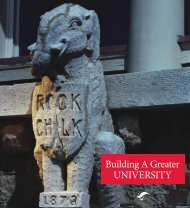download a PDF version - KU Endowment
download a PDF version - KU Endowment
download a PDF version - KU Endowment
You also want an ePaper? Increase the reach of your titles
YUMPU automatically turns print PDFs into web optimized ePapers that Google loves.
“Basically, we’re functionally reconnecting the<br />
brain and spinal cord with electronic devices,” he<br />
said. “We are designing circuits like a computer on<br />
the head of a pin.”<br />
A bridge of cells<br />
Unlike nerves outside the central nervous system, the<br />
nerves in the spinal cord cannot regenerate or repair<br />
themselves. Smith’s team is working on a treatment<br />
involving new cells with the ability to repair the<br />
damage for good.<br />
“A more permanent treatment would be reconnecting<br />
those wires, which means replacing dead cells,”<br />
Smith said. “If we can discover the right kinds of<br />
cells and the right technique to move them back into<br />
the spinal cord, we can get them to create new pathways<br />
and restore function below the lesion.”<br />
Top: Peter Smith and Dora Agbas, Ph.D., examine sections of injured<br />
spinal cords. Agbas is a research assistant professor of molecular and<br />
integrative physiology.<br />
Above: Smith’s team took a patient’s skin cells, converted them to stem<br />
cells, and induced them to grow into these adult nerve cells.<br />
<strong>KU</strong>ENDOWMENT.ORG 11











